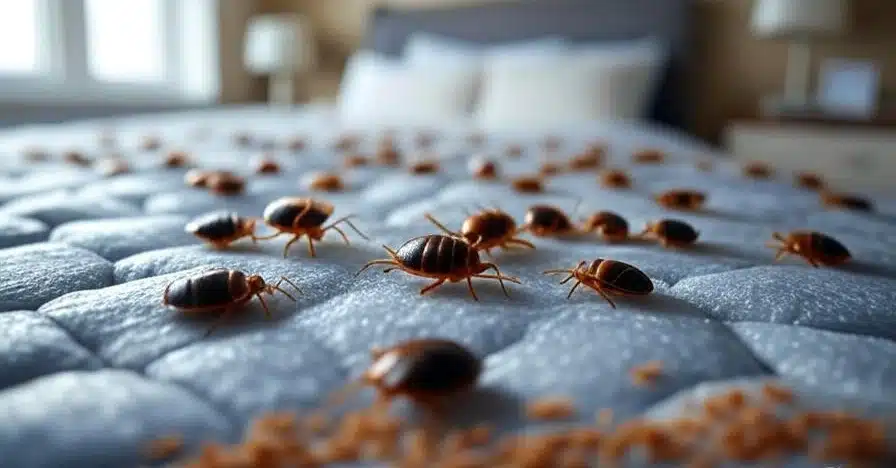
Introduction
Bed bugs are a persistent problem in London, sneaking into homes and causing distress with their itchy bites. As infestations rise across the UK in 2025, many are turning to DIY solutions like diatomaceous earth, hoping for an effective, natural fix. But does diatomaceous earth kill bed bugs? In this article, we’ll explore the science behind this powdery substance, assess its effectiveness, and explain why professional treatments from ThermoPest offer the most reliable solution for UK homes.
Understanding Bed Bugs in London
Bed bugs are small, blood-feeding insects that thrive in warm, human-filled environments. They hide in mattresses, furniture, clothing, and even wall crevices, emerging at night to feed. London’s busy lifestyle—crowded public transport, shared flats, and frequent travel—makes it a hotspot for bed bug spread. These pests don’t discriminate by cleanliness; they just need a host and a hiding spot.
Why Bed Bugs Are Hard to Eradicate
Bed bugs are tough opponents. A single female can lay hundreds of eggs, each tiny and resistant to many treatments. Adults can survive months without feeding, making quick fixes challenging. This resilience drives interest in solutions like diatomaceous earth, but not all remedies deliver lasting results.
A Londoner’s Experience
Take James, a London student who found bed bugs in his rented flat. He sprinkled diatomaceous earth around his room, hoping to end the infestation. While it killed some bugs, the problem persisted, and James eventually needed professional help to fully clear his home.
Does Diatomaceous Earth Kill Bed Bugs?
So, does diatomaceous earth kill bed bugs? Yes, it can—but it’s not a complete solution. Diatomaceous earth (DE) is a fine powder made from fossilised algae, known for its ability to kill insects by damaging their exoskeletons. When used correctly, it can be effective against bed bugs, but it has significant limitations in a home setting.
How Diatomaceous Earth Works
DE works by absorbing the waxy outer layer of a bed bug’s exoskeleton, causing them to dehydrate and die. It’s most effective when bugs crawl through it, so it must be applied in areas where bed bugs are active. Food-grade DE is safe for home use, but it requires careful application to avoid health risks.
Limitations of Diatomaceous Earth
While DE can kill bed bugs, it’s slow-acting, often taking days to weeks to show results. It only works on bugs that come into direct contact with it, missing those hidden in deep crevices or eggs glued to surfaces. Improper use—like over-application—can create a dusty mess or irritate lungs, especially for asthma sufferers. The NHS bedbug guide recommends professional treatment over DIY methods for faster, more reliable results.
Risks and Challenges of Using Diatomaceous Earth
Using DE requires precision and patience, which can be tricky in a busy London home. It’s not a quick fix, and misapplication can reduce its effectiveness or pose health risks. Scattering DE haphazardly may also scatter bed bugs, worsening the infestation.
Health and Safety Concerns
Inhaling DE dust can irritate the respiratory system, particularly if you use non-food-grade versions. It can also be messy, clinging to furniture or creating a cleanup nightmare. For households with children or pets, keeping DE contained is a challenge.
James’s Lesson
James’s DE experiment killed some bugs but didn’t stop the infestation. The powder spread across his flat, and the bugs moved to new hiding spots. By the time he called professionals, the problem was bigger than he’d expected, costing him more time and money.
Proven Solutions with ThermoPest
While diatomaceous earth can play a role in bed bug control, it’s no match for professional pest control. At ThermoPest, we use advanced heat treatment to eliminate bed bugs at every life stage—eggs, nymphs, and adults—in a single visit. Our eco-friendly method is safe and effective. Learn more at our bed bug treatment page.
Why Heat Treatment Works
Our heat treatment raises temperatures to 49°C–60°C, a range lethal to bed bugs. Unlike DE, which relies on contact, heat penetrates deep into mattresses, furniture, and walls, ensuring no bug survives. It’s chemical-free, allowing you to return home the same day with no lingering dust or odours.
ThermoPest’s Advantage
With extensive experience in London, ThermoPest combines state-of-the-art technology with local know-how. We offer a 60-day warranty, transparent pricing, and tailored solutions for any home or business. Our goal is to deliver lasting relief from bed bugs.
Conclusion
In short, does diatomaceous earth kill bed bugs? Yes, but it’s slow, limited, and not a complete solution for London homes. For fast, reliable results, professional heat treatment is the way to go. If bed bugs are plaguing your home, contact ThermoPest for a free consultation and sleep soundly again.
Additional Resources
For more on bed bugs, visit the NHS bedbug guide. To explore our services, check out our bed bug treatment page or the ThermoPest main website.
